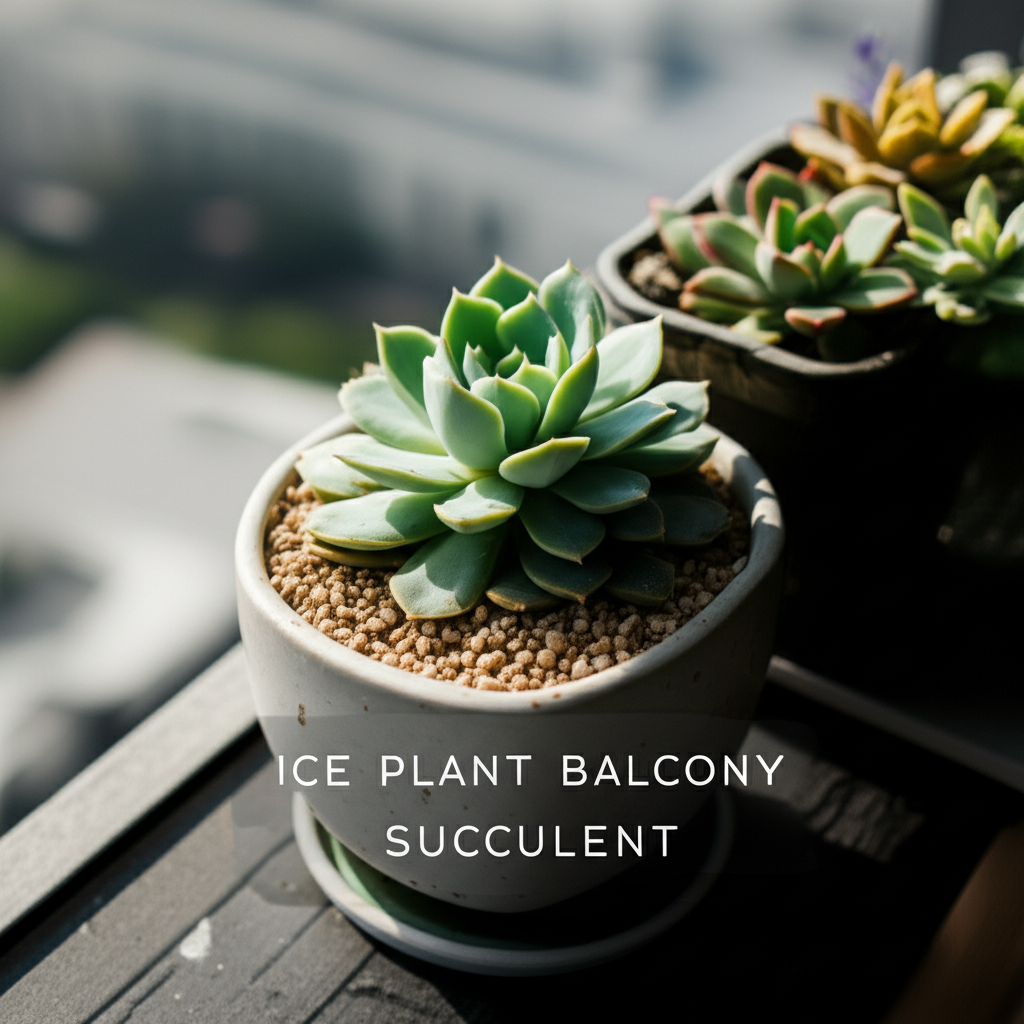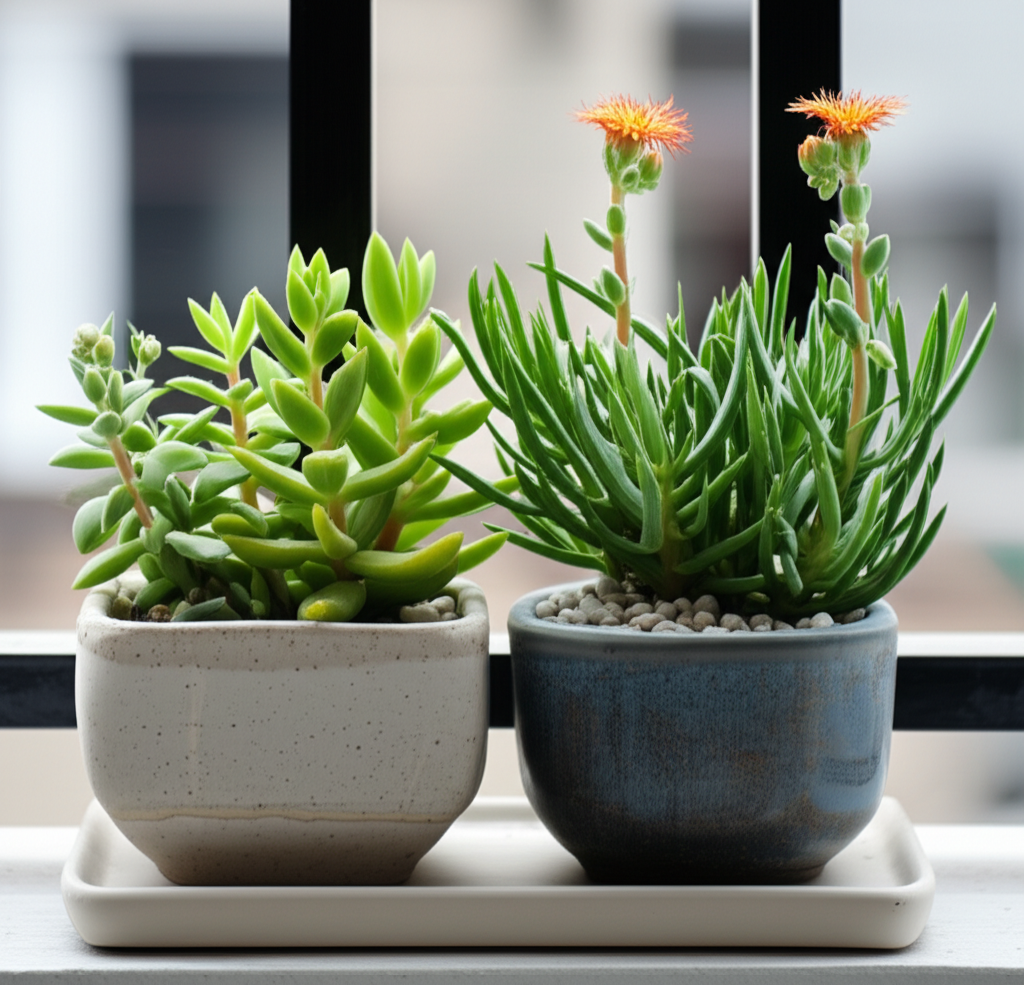Embracing the Ice Plant: A Tiny Balcony’s Succulent Secret
For urban dwellers with limited outdoor space, a balcony can be a precious sanctuary. Transforming a compact balcony into a vibrant, green haven is a dream for many, and succulents offer an incredibly rewarding path to achieving this. Among the diverse succulent family, the ice plant (likely referring to the Delosperma genus, known for its sparkling, crystalline epidermal cells) stands out as a particularly compelling choice for small-space gardening. Its jewel-like appearance, drought tolerance, and adaptability make it a perfect candidate for balcony containers. This article will guide you through creating stunning and practical ice plant succulent layouts for your tiny balcony, maximizing both aesthetics and plant health.
Why Ice Plants for Your Tiny Balcony?
Ice plants are more than just visually appealing; they are remarkably well-suited for the unique challenges and opportunities presented by balcony gardening.
- Drought Tolerance: Balcony containers can dry out quickly, especially in hot weather. Ice plants, like most succulents, store water in their leaves, stems, and roots, making them exceptionally resilient to periods of dryness. This significantly reduces the watering frequency required.
- Low Maintenance: Beyond occasional watering and adequate sunlight, ice plants demand very little attention. They don’t require frequent repotting, pruning, or special soil amendments, making them ideal for busy individuals or novice gardeners.
- Compact Growth Habit: Many ice plant varieties exhibit a creeping or trailing growth pattern, which is perfect for spilling over the edges of pots and hanging baskets. This maximizes visual impact in a small footprint.
- Sunlight Requirements: Ice plants thrive in full sun, a condition often readily available on balconies. Their need for ample sunlight directly contributes to their vibrant colors and healthy growth.
- Unique Aesthetic: The distinctive crystalline structures on their leaves give ice plants their name, reflecting sunlight and creating a “sparkling” effect. This adds an element of surprise and visual interest to any arrangement.
Designing Your Tiny Balcony Succulent Layout

Creating a successful succulent layout on a small balcony is about strategic planning and thoughtful plant selection. The goal is to create a cohesive and visually appealing display that thrives in the specific conditions of your balcony.
Assessing Your Balcony Environment
Before purchasing any plants, it’s crucial to understand your balcony’s microclimate.
- Sunlight Exposure: Observe how much direct sunlight your balcony receives throughout the day and during different seasons. Most ice plants require at least six hours of direct sunlight daily.
- Wind Exposure: Balconies can be windy, which can dry out plants quickly. Consider windbreaks or choosing more robust varieties.
- Space Constraints: Measure your available space for pots, hanging baskets, and any vertical gardening elements.
- Weight Limitations: Be mindful of the weight of your containers, soil, and plants, especially on older balconies. Opt for lighter materials where possible.
Key Succulent Companions for Ice Plants
While ice plants are the stars, pairing them with complementary succulents can create a dynamic and layered display. Consider the growth habits and aesthetic of other succulents.
Trailing and Cascading Succulents
These are ideal for creating a “spill-over” effect from containers.
- String of Pearls (Senecio rowleyanus): Its bead-like leaves offer a unique texture and graceful drape.
- String of Bananas (Senecio radicans): Similar to String of Pearls but with banana-shaped leaves.
- Burro’s Tail (Sedum morganianum): Features thick, fleshy, trailing stems covered in plump leaves.
- Graptosedum ‘California Sunset’: Offers beautiful pastel hues and a trailing habit.
Upright and Architectural Succulents
These provide height and structure to your arrangement.
- Echeveria varieties: Known for their rosette shapes and wide array of colors.
- Sempervivum (Hens and Chicks): Hardy and produce offsets (chicks) around the mother plant (hen).
- Aloe varieties (smaller types): Offer architectural form and interesting textures.
- Haworthia varieties: Often smaller and have striking patterns and textures.
Container Selection for Tiny Balconies
The right containers are vital for both the health of your succulents and the aesthetic of your balcony.
- Drainage is Paramount: All containers must have drainage holes to prevent root rot, the most common killer of succulents.
- Material Matters:
- Terracotta: Porous, allowing for better airflow and quicker drying, which is beneficial for succulents. It can be heavy.
- Ceramic/Glazed Pots: Offer a decorative appeal but can retain more moisture. Ensure excellent drainage.
- Plastic/Resin: Lightweight and retain moisture longer.
- Metal: Can become very hot in direct sun, potentially damaging roots.
- Size and Shape:
- Shallow, wide containers: Ideal for showcasing trailing ice plants and creating a layered look.
- Hanging baskets: Perfect for allowing ice plants and other trailers to cascade.
- Vertical planters: Maximize vertical space, great for smaller succulents.
Building Your Ice Plant Succulent Layouts: Step-by-Step
Creating a beautiful and thriving succulent garden on your balcony doesn’t have to be complicated. Follow these steps for success.
Step-by-Step Layout Creation
1. Preparation is Key
- Gather Your Supplies: Containers, succulent/cactus potting mix, slow-release fertilizer (optional), trowel, watering can.
- Choose Your Potting Mix: Use a well-draining potting mix specifically formulated for succulents and cacti. You can also create your own by mixing potting soil with perlite or pumice (about a 1:1 ratio).
2. Planting Your Ice Plants and Companions
- Arrange Before Planting: Before filling pots, place your succulents in their containers to visualize the arrangement. Consider the mature size and growth habit of each plant.
- Planting Technique: Gently remove succulents from their nursery pots, taking care not to damage the roots. If the roots are tightly bound, gently loosen them.
- Positioning: Place taller, upright succulents towards the back or center of the arrangement, and trailing succulents around the edges to cascade downwards. Ice plants can be placed as ground cover, cascading elements, or central features depending on the variety.
- Filling with Soil: Fill the container with your succulent potting mix, ensuring the soil level is about an inch below the rim of the pot. Gently firm the soil around the base of each plant.
3. Watering and Initial Care
- Initial Watering: Wait a day or two after planting before watering. This allows any damaged roots to heal and prevents rot. When you do water, water thoroughly until it drains from the bottom.
- Placement: Position your planted containers in their final sunny location.
4. Ongoing Care and Maintenance
- Watering: Water only when the soil is completely dry. Stick your finger about an inch into the soil; if it feels dry, it’s time to water. Overwatering is the most common mistake.
- Sunlight: Ensure your succulents receive at least six hours of direct sunlight daily. If your balcony gets intense afternoon sun, consider providing some afternoon shade to prevent scorching, especially for younger plants.
- Fertilizing: Succulents are not heavy feeders. Fertilize sparingly during the growing season (spring and summer) with a diluted, balanced liquid fertilizer or a succulent-specific fertilizer.
- Pest Control: Keep an eye out for common succulent pests like mealybugs and spider mites. Treat infestations promptly with insecticidal soap or neem oil.
- Pruning: Trim away any dead or leggy growth to maintain the plant’s shape and encourage bushier growth. Cuttings can often be propagated to create new plants.
Key Facts and Comparison: Ice Plants vs. Other Balcony Succulents
Understanding the characteristics of ice plants in comparison to other popular balcony succulents can help you make informed design choices.
| Feature | Ice Plant (Delosperma) | Echeveria | Sempervivum | Sedum (trailing varieties) |
|---|---|---|---|---|
| Growth Habit | Creeping, trailing, groundcover | Rosette, upright | Rosette, clumping | Trailing, creeping |
| Drought Tolerance | Excellent | Very Good | Excellent | Very Good |
| Sunlight Needs | Full Sun | Full Sun to Partial Shade | Full Sun | Full Sun |
| Watering Needs | Infrequent, when dry | Infrequent, when dry | Infrequent, when dry | Infrequent, when dry |
| Winter Hardiness | Varies by species, some hardy | Generally not frost-tolerant | Very hardy | Varies by species, some hardy |
| Unique Aesthetic | “Sparkling” crystalline epidermal cells | Symmetrical rosettes, vibrant colors | Hardy, produces offsets | Fleshy leaves, trailing |
| Best Use on Balcony | Cascading, ground cover, container edges | Focal point, mixed arrangements | Ground cover, rock gardens, mixed arrangements | Cascading, spill-over |
Pros and Cons of Ice Plant Succulent Layouts
Every gardening choice comes with its advantages and disadvantages. Here’s a look at what to expect with ice plant succulent layouts.
| Category | Details |
|---|---|
| Pros |
|
| Cons |
|
Maximizing Your Tiny Balcony Space: Creative Layout Ideas
With a little creativity, even the smallest balcony can become a lush succulent paradise.
Vertical Gardening and Hanging Displays
Utilize vertical space to create visual interest and maximize planting area.
- Tiered Planters: Stacked planters or shelves allow you to display multiple succulents at different heights.
- Wall-Mounted Planters: Attach small planters or pockets to a balcony railing or wall for a living green wall effect.
- Hanging Baskets: Ideal for trailing ice plants and other cascading succulents. Position them where they can receive ample sunlight and create a beautiful downward flow.
Mixed Container Arrangements
Combine different types of containers and succulents for a dynamic display.
- The “Spill and Thrill” Method: Use a thriller plant (upright, dramatic) in the center, a filler plant (bushy, mounding) around it, and a spiller plant (trailing) to cascade over the edges. Ice plants are excellent “spillers.”
- Color and Texture Contrasts: Pair the unique texture of ice plants with the smooth leaves of Echeverias or the spiky form of Aloes for visual contrast.
- Themed Groupings: Create small groupings of containers with similar color palettes or plant types for a cohesive look.
Balcony Layout Inspiration
- The Cascading Edge: A row of shallow terracotta pots along the balcony railing, planted with various trailing ice plants and succulents, allowing them to spill over the edge like a living waterfall.
- The Sunken Garden Feel: Larger, wider containers placed on the floor, with taller succulents in the center and ice plants artfully arranged around the perimeter, creating a sense of depth.
- The Vertical Statement: A small balcony wall adorned with hanging baskets and wall-mounted planters, featuring a variety of succulents, with ice plants trailing from the highest points.
- The Minimalist Display: A few well-chosen ceramic pots, each containing a single, striking succulent variety, with one or two featuring cascading ice plants for a touch of softness.
Conclusion: Your Tiny Balcony Succulent Oasis Awaits
Transforming a small balcony into a vibrant, green sanctuary is entirely achievable, and ice plants are your secret weapon. Their resilience, unique beauty, and adaptable nature make them perfect for urban gardening. By understanding your balcony’s environment, choosing the right companions and containers, and following these simple care guidelines, you can cultivate a thriving ice plant succulent layout that brings joy and natural beauty to your compact outdoor space. Embrace the process, experiment with different arrangements, and enjoy the sparkling rewards of your tiny balcony oasis.


